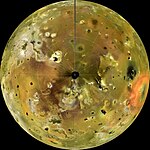File:Iorotateing1day.ogv
Iorotateing1day.ogv (Ogg Theora video file, length 24 s, 640 × 480 pixels, 1.11 Mbps, file size: 3.17 MB)
Captions
Captions
Summary edit
 | |
 North Pole Grid |
 South Pole Grid |
| Target Name: | Io |
| Is a satellite of: | Jupiter |
| Mission: | Galileo mission Voyager program |
| Spacecraft: | Galileo Voyager 1 |
| Instrument: | Solid-State Imaging |
| Product Size: | 11445 samples x 3643 lines |
| Produced By: | U.S. Geological Survey |
| Primary Data Set: | N/A |
| Full-Res file: | PIA09257.mpg (3.3 MB) |
PIA09257: Io in Motion
Io is the most volcanically active body in the Solar System. Volcanoes
erupt massive volumes of silicate lava, sulphur and sulphur dioxide,
constantly changing Io's appearance. This new basemap of Jupiter's moon Io
was produced by combining the best images from both the Voyager 1 and
Galileo Missions. Although the subjovian hemisphere of Io was poorly seen
by Galileo, superbly detailed Voyager 1 images cover longitudes from 240 W
to 40 W and the nearby southern latitudes. A monochrome mosaic of the
highest resolution images from both Galileo and Voyager 1 was assembled
that includes 51 Voyager 1 images with spatial resolutions sometimes
exceeding the 1 km/pixel scale of the final mosaic. Because this mosaic is
made up of images taken at various local times of day, care must be taken
to note the solar illumination direction when deciding whether topographic
features display positive or negative relief. In general, the illumination
is from the west over longitudes 40 to 270 W, and from the east over
longitudes 270 W to 40 W. Color information was later superimposed from
Galileo low phase angle violet, green, and near-infrared (756 nanometer
wavelength) images. The Galileo SSI camera's silicon CCD was sensitive to
longer wavelengths than the vidicon cameras of Voyager, so that
distinctions between red and yellow hues can be more easily discerned. The
"true" colors that would be visible to the eye are similar but much more
muted than shown here. Image resolutions range from 1 to 10 km/pixel along
the equator, with the poorest coverage centered on longitude 50 W.
This mosaic is in an equal area cylindrical map projection, centered onlongitude 180, with grid lines at 30 degree intervals. Full scale versions of this mosaic, and the data products used to generate it, can be obtained from the USGS Astrogeology website, https://astrogeology.usgs.gov/Projects/JupiterSatellites/.
About the Animation
- Animation file: Image:Iorotateing1day.ogg
In the same way that the Moon always has the same side facing Earth, Io always has the same side facing Jupiter. The movie shows two speeded-up rotations of Io (a single rotation really takes 1.77 days), and begins with a view of the Jupiter-facing hemisphere. With rotation in an easterly direction, after two seconds the volcano Prometheus (on the equator) comes into view. The massive red deposit around Pele (seconds 5-10) is the most distinctive expression of volcanic activity on Io, and just to the north-west is the horse shoe-shaped Loki Patera, the most powerful volcano on Io.
The animation was made using a computer program that wrapped the Io mosaic around a sphere to produce a globe. In all, 360 images were used, each differing by one degree in longitude from the previous image.
- Source: https://photojournal.jpl.nasa.gov/catalog/PIA09257 (direct link)
Source: https://photojournal.jpl.nasa.gov/animation/PIA09257
Licensing edit
| Public domainPublic domainfalsefalse |
| This file is in the public domain in the United States because it was solely created by NASA. NASA copyright policy states that "NASA material is not protected by copyright unless noted". (See Template:PD-USGov, NASA copyright policy page or JPL Image Use Policy.) |  | |
 |
Warnings:
|
File history
Click on a date/time to view the file as it appeared at that time.
| Date/Time | Thumbnail | Dimensions | User | Comment | |
|---|---|---|---|---|---|
| current | 01:14, 6 May 2007 | 24 s, 640 × 480 (3.17 MB) | Geni (talk | contribs) | {{Information |Description=Io rotateing |Source=http://photojournal.jpl.nasa.gov/animation/PIA09257 |Date= |Author=NASA |Permission= |other_versions= }} |
You cannot overwrite this file.
File usage on Commons
The following 7 pages use this file:
Transcode status
Update transcode statusFile usage on other wikis
The following other wikis use this file:
- Usage on bn.wikipedia.org
- Usage on cs.wikipedia.org
- Usage on en.wikipedia.org
- Usage on en.wikiversity.org
- Usage on fa.wikipedia.org
- Usage on hi.wikipedia.org
- Usage on hy.wikipedia.org
- Usage on it.wikipedia.org
- Usage on ja.wikipedia.org
- Usage on ko.wikipedia.org
- Usage on mk.wikipedia.org
- Usage on nl.wikipedia.org
- Usage on no.wikipedia.org
- Usage on ro.wikipedia.org
- Usage on ru.wikipedia.org
- Usage on sk.wikipedia.org
- Usage on sw.wikipedia.org
- Usage on uk.wikipedia.org
- Usage on www.wikidata.org
- Usage on zh.wikipedia.org
Metadata
This file contains additional information such as Exif metadata which may have been added by the digital camera, scanner, or software program used to create or digitize it. If the file has been modified from its original state, some details such as the timestamp may not fully reflect those of the original file. The timestamp is only as accurate as the clock in the camera, and it may be completely wrong.
| Software used |
|---|